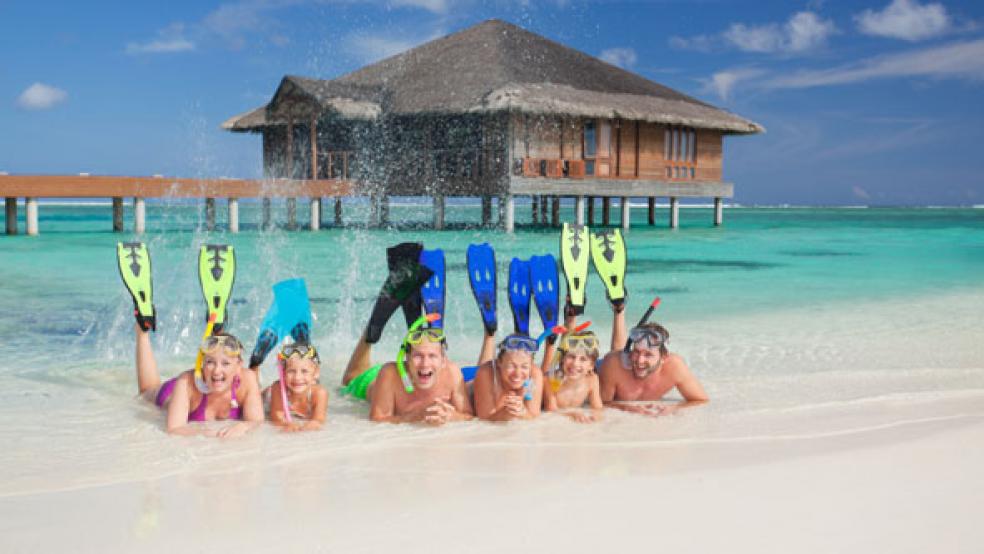Here comes the sun…and no matter how you plan to enjoy it, be careful to keep your skin safe.
For their July issue, Consumer Reports tested 65 sunscreens, from lotions to sprays to sticks — and found that 43 percent of them failed to meet the Sun Protection Factor, or SPF, claim on their labels.
The SPF number is a measure of how well a sunscreen shields your skin against ultraviolet B rays, the main cause of sunburn. Applied properly, an SPF 30 sunscreen will protect you from the sun’s rays for 30 times as long as not wearing sunscreen.
Related: 10 Best Beaches in America
The American Academy of Dermatology recommends that people use sunscreens with an SPF of at least 30. Also, there is no evidence as of yet that sunscreens with SPFs over 50 can protect any better than those of SPF 50. And there is no sunscreen that can block all of the sun’s rays. So even if you slather on lotion that you think will protect you, don’t forget about other forms of sun protection — shade, hats and as much clothing as you can.
Fully 70 percent of sunscreen shoppers say they look for “broad-spectrum” protection, according to Consumer Reports’ survey. But a third of those shoppers incorrectly believed that “broad-spectrum” implies all-day protection. Instead, a broad-spectrum sunscreen protects against UVA rays in addition to UVB. UVA rays penetrate the skin more deeply than UVB rays. They play a large role in skin aging and wrinkling, and may even initiate skin cancers.
Remember to wait 15 to 30 minutes between applying sunscreen and going out in the sun, and to re-apply sunscreen every two hours. Also, keep in mind that the active ingredients in sunscreen only maintain their effectiveness for three years, so if your sunscreen doesn’t have an expiration date on the bottle, write the purchase date on it. And toss it if it’s more than three years old.
Related: 10 Best Towns Where You Can Find a Beach Bargain
Here are Consumer Reports’ recommended sunscreens, all of which meet their claimed SPF:
Lotions (7)
1. Anthelios 60 Melt-In Sunscreen Milk (SPF 60)
Brand: La Roche-Posay
Cost Per Oz.: $7.20
Consumer Reports Score: 100
2. SPF 50 Disney Frozen
Brand: Pure Sun Defense
Cost Per Oz.: $0.79
Consumer Reports Score: 98
3. Water Babies SPF 50
Brand: Coppertone
Cost Per Oz.: $1.31
Consumer Reports Score: 98
4. Ultra Protection SPF 50 (Walmart)
Brand: Equate
Cost Per Oz.: $0.49
Consumer Reports Score: 94
5. Sport SPF 50
Brand: No-Ad
Cost Per Oz.: $0.63
Consumer Reports Score: 88
6. Protect & Nourish SPF 30
Brand: Ocean Portion
Cost Per Oz.: $1.00
Consumer Reports Score: 87
7. Protect + Hydrate SPF 30
Brand: Aveeno
Cost Per Oz.: $3.33
Consumer Reports Score: 84
Sprays (6)
1. Spray SPF 50+
Brand: Trader Joe’s
Cost Per Oz.: $1.00
Consumer Reports Score: 100
2. SunComfort Continuous Spray SPF 50+
Brand: Banana Boat
Cost Per Oz.: $1.67
Consumer Reports Score: 97
3. Beach Defense Water + Sun Protection SPF 70
Brand: Neutrogena
Cost Per Oz.: $1.62
Consumer Reports Score: 88
4. Continuous Tropical Mist SPF 70
Brand: Caribbean Breeze
Cost Per Oz.: $2.77
Consumer Reports Score: 84
5. Sport Continuous Spray SPF 30 (Walmart)
Brand: Equate
Cost Per Oz.: $0.83
Consumer Reports Score: 84
6. Sport SPF 30 (Dollar General)
Brand: DG Body
Cost Per Oz.: $0.88
Consumer Reports Score: 82
Stick Sunscreens
1. Kids Stick SPF 55
Brand: Coppertone
Cost Per Oz.: $9.17
Consumer Reports Score: 87
2. Kids Stick SPF 55 (Target)
Brand: Up & Up
Cost Per Oz.: $5.83
Consumer Reports Score: 84
Facial Sunscreens
1. Sun+ Sunscreen Face Lotion SPF 40
Brand: Avon
Cost Per Oz.: $3.00
Consumer Reports Score: 85
2. Ultra Sheer SPF 30 (Target)
Brand: Up & Up
Cost Per Oz.: $1.73
Consumer Reports Score: 83




